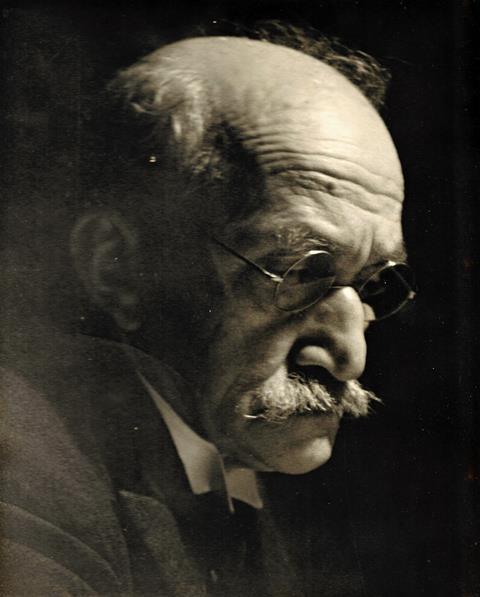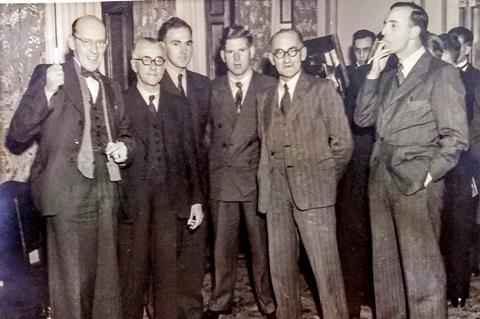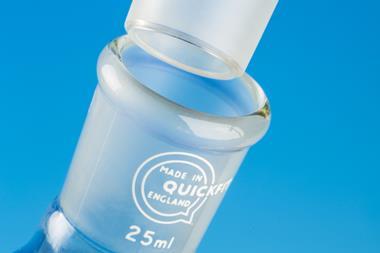The family firm that introduced standard glassware joints to Britain
In 1864 the writer Herbert Spencer paraphrased Charles Darwin’s idea of natural selection with the potent slogan ‘survival of the fittest’. Although Darwin himself would adopt the phrase, it struck a particular chord with the social and political Darwinists who likened society and the world of business to a dog-eat-dog world in which the weak were trampled and the strong and aggressive would thrive. Yet the analogy, while seductive, is in many ways misleading, as can be illustrated by the story of interchangeable ground glass joints in the UK. Today these fittings are almost synonymous with the name Quickfit, but their origin goes back two decades earlier than that brand.

As we explored in the last Classic Kit, the standardisation of glassware generally, and of ground glass joints in particular, began in Germany – in particular, in Thuringia – after the First World War (Chemistry World, November 2019, p68). Fritz Friedrichs, unusual in being both an experienced research chemist as well as being born into one of the most important scientific glassblowing businesses, Greiner & Friedrichs, spearheaded this effort. But others had been thinking along the same lines.
As we explored in the last Classic Kit, the standardisation of glassware generally, and of ground glass joints in particular, began in Germany – in particular, in Thuringia – after the First World War. Fritz Friedrichs, unusual in being both an experienced research chemist as well as being born into one of the most important scientific glassblowing businesses, Greiner & Friedrichs, spearheaded this effort. But others had been thinking along the same lines.
One was Frank Flaig, one of three sons (along with William and Ernest) of another Thuringian emigré, Wilhelm G Flaig. Wilhelm, born to a mother who was a member of the Greiner family, almost certainly trained as a glassblower with Greiner & Friedrichs. Along with numerous other of his contemporaries, Wilhelm moved to Britain sometime between 1881 and 1885 when the electric lamp business was taking off. He is listed as living near Ponders End, where the Edison & Swan lighting works were located, and later in Kempston, where he may have worked for the Crystal Electric Light Company.
By 1903 Flaig had moved back to the innovation hub that was Hatton Garden in London, where small technical firms existed cheek-by-jowl with jewellers. He worked for Baird and Tatlock (the London, rather than the Glasgow firm), the laboratory supplies company, a job that his family speculate might have been more interesting than making lightbulbs.
Wilhelm’s son Frank almost certainly apprenticed with Baird and Tatlock. In 1912, at the age of 23, Frank set up W G Flaig, a technical glassblowing business, at 57 Hatton Garden. One of their customers was Joseph Barcroft of Cambridge University, one of the pioneers of respiratory physiology. Working with John Scott Haldane, Barcroft had developed a device to measure the degree of oxygenation of the blood. In 1908 he had simplified things further, announcing a sensitive differential manometer that would be further improved by Otto Warburg.
The manometer consisted of a capillary U-tube loaded with a solution of bile salts of precisely known density. Each arm of the U was equipped with a pair of small bottles or conical flasks attached to each arm, each containing a sample of blood. To release the oxygen from one sample, tartarate or ferricyanide was added to the blood in one flask. Long before magnetic stirring, the entire apparatus had to be shaken to equilibrate the samples. Breakages were almost inevitable.

In the original 1908 paper, Barcroft pointed out that ground glass joints held together far better when shaken. On the other hand, conical flasks attached by rubber bungs were easier to replace when broken. In a footnote, however, Barcroft writes ‘I have since had an apparatus made with conical flasks and ground glass joints’. In 1910 he reported a further improvement, stating that it had been made by Baird and Tatlock, for whom the Flaigs were still working at the time. Could it be that Frank Flaig saw an opportunity to set up on his own, taking some of his employer’s clients with him?

It occurred to Flaig that standard joints would simplify the regular repairs that were necessary, which in the non-standardised era required regrinding each cone and socket every time. The connections became known in the Flaig firm as ‘Barcroft joints’. Flaig began to make apparatus with standard joints specified in imperial units, which they began to sell under the Exelo brand name – the first standard joints in Britain. There is, however, no evidence that they patented or protected their products, though the Exelo trademark would be registered in the 1960s.
In the 1920s the Flaigs became aware of German competition in the form of standard joints specified in metric units. According to an unsigned memoir written years later, WG Flaig took out an advertisement in Nature in 1928 for their Exelo glassware. A search of Nature advertising between 1925 and 1929 has turned up no such ad. On the other hand, the Stützerbach firm Wilhelm Heinz took out half a dozen ads in 1927, showing both separate cones and sockets and complete devices such as a Soxhlet extractor (Chemistry World, September 2007, p77) with a three-ball Allihn condenser (Chemistry World, May 2010, p66), all equipped with ground glass joints.
In the 1920s the Flaigs became aware of German competition in the form of standard joints specified in metric units. According to an unsigned memoir written years later, WG Flaig took out an advertisement in Nature in 1928 for their Exelo glassware. A search of Nature advertising between 1925 and 1929 has turned up no such ad. On the other hand, the Stützerbach firm Wilhelm Heinz took out half a dozen ads in 1927, showing both separate cones and sockets and complete devices such as a Soxhlet extractor with a three-ball Allihn condenser, all equipped with ground glass joints.
Commercial standards for glassware began to appear at around this time. In the United States, standard CS21-30 of 1930 confirmed the 1 in 10 taper. In the UK the standard of 1934 used the same taper and laid down four classes of joints, A to D, to specify the length of the ground glass section in relation to the diameter. The short D joints were designed for weighing bottles, while the longer A and B were used for connecting one flask to the next. Later still, in 1950 the revised specification did away with the A class joints which were impractically long – the B class became the most common joint. The names B14, B19 and B24 have endured even though the letters were replaced by the American practices of using two numbers, such as 24/40, indicating the maximum width and the length of the ground glass section.
With a unique set of products and rapidly growing markets, the Flaig business bloomed. In 1935 they incorporated, developed their Exelo range, and moved out of London, first to Cricklewood and then to Margate. They had good timing. Hatton Garden would be savagely bombed in the Blitz.

Over the next 25 years the Flaigs would expand their business, opening offices in Belgium, Canada and Australia, and making a wide range of standard and more specialist glassware, all of it with ground glass joints. A patent from 1950 described a ‘safety pipette’ for noxious substances that avoided the need either for pipetting by mouth, or using a fiddly bulb. It consisted of a pipette equipped with a ground glass joint, into which fitted a syringe attachment to draw liquid into the pipette; a small hole in the side of the syringe allowed the liquid to be released in a controlled fashion. It was effective, but would be totally superseded by the spring-loaded mechanical pipettes devised by Schnitger that are today known as Eppendorfs or Gilsons (Chemistry World, October 2014, p35).
Over the next 25 years the Flaigs would expand their business, opening offices in Belgium, Canada and Australia, and making a wide range of standard and more specialist glassware, all of it with ground glass joints. A patent from 1950 described a ‘safety pipette’ for noxious substances that avoided the need either for pipetting by mouth, or using a fiddly bulb. It consisted of a pipette equipped with a ground glass joint, into which fitted a syringe attachment to draw liquid into the pipette; a small hole in the side of the syringe allowed the liquid to be released in a controlled fashion. It was effective, but would be totally superseded by the spring-loaded mechanical pipettes devised by Heinrich Schnitger that are today known as Eppendorfs or Gilsons.
But competition was fierce and in the 1980s it was all over, as the entire industry was hit by wave after wave of consolidation. WG Flaig was taken over by Bibby’s, which today is SciLabWare. And the name Flaig is forgotten, having fallen into the shadow of a product – Quickfit. While some might see business as a Red Queen’s game, in which one has to run to stand still, the reality is subtly different. The Flaig name has disappeared, but the creativity and skill involved in their innovation was simply absorbed into other businesses. Like Richard Dawkins’ selfish genes, the meme-like ideas simply moved from one firm to another and are as useful and fit today as they were back in 1915.
Acknowledgments
We are grateful to Pauline Gotts and to Tony Flaig for information and permission to publish family photographs
Further reading
The story of Quickfit, part one: Fritz Friedrichs sets the standards for ground glass joints
The story of Quickfit, part three: Leslie Scorah’s work leads to the trademark
References
A. Gall, Brit. Soc. Sci. Glassblowers J., 2015, 53, 66
J. Barcroft, J. Physiol., 1908, 37, 12
J. Barcroft and F F Roberts, J. Physiol., 1910, 39, 429
J. Barcroft and H L Higgins, J. Physiol., 1908, 42, 512
The story of Quickfit, part one: Friedrich's joints
- 1
- 2
 Currently reading
Currently readingFlaig’s joints and Barcroft’s manometer
- 3














No comments yet